
David Skilling
Across the developed world, countries are facing a series of structural challenges associated with a disruptively changing global environment. In response, governments are seeking to develop policies to restore competitiveness, to return to fiscal sustainability, and to redefine the social compact. Singapore too is facing a series of challenges, such as the need to transition to productivity-led growth and to address income distribution and social mobility issues.
Much of the attention is focused, perhaps unsurprisingly, on the policy debates in large countries like the US or large country groupings like the G20. Unfortunately this perspective does not provide much confidence: several large developed countries are struggling to respond to the structural changes in the global economy, and the large country groupings are not making meaningful progress. Indeed, policy fatalism, a sense that there is not much that governments can do in the face of these tectonic movements, is increasingly apparent.
But there is a group of developed countries that is successfully engaging with the global economy – the small economies. These small developed countries, which I define as advanced economies with populations of less than 20 million, do not loom large in the global policy debates. But there are three reasons why small countries should get much more attention.
First, taken as a group, these small countries account for a sizable proportion of global GDP. In 2011, the 23 small advanced economies made up 9% of global GDP at market exchange rates. That is more than Japan, and only just below China – now the world’s second largest economy – at 10%. And while large advanced economies have experienced a steady decline in their global GDP share, the share of these small countries has remained constant at 9% for the past 30 years. So although individually small, taken together these small countries are a meaningful economic unit.
Second, small countries have out-performed their larger counterparts on a wide range of economic and social outcomes. On economic measures, small countries generated stronger rates of economic growth, grew their levels of exporting and foreign investment very substantially, and have consistently been over-represented in measures of global competitiveness. There were clearly strong contributions from the small Asian economies of Singapore and Hong Kong, but the strong performance was broad-based.
Interestingly, this small country performance has been particularly strong over the past 15 years even as globalisation has become more intense and developed countries have had to adjust to competition from emerging markets. And for many small countries, this strong economic performance has occurred in parallel with strong performance on social outcomes such as income distribution. This record suggests that many small countries have responded appropriately to the emerging global environment.
The record of performance by small developed countries shows that developed countries can prosper, and that policy fatalism is not warranted. But neither is complacency. There are many structural challenges ahead for small economies, and small countries will need to work even harder and more creatively; to develop a strong and sustainable competitive position, to manage risk exposures and build resilience, and to develop a portfolio of external relationships. Indeed, some small countries will likely not succeed in this endeavour, as the recent experience of Greece and some other small European countries indicates. But in general, small countries seem to have the ability to adapt themselves to the global environment.
Singapore is one such country that has adapted flexibly to a changing environment over the years, and it will need to continue to adapt now. The domestic and international environment facing Singapore policy-makers are quite different than a decade or two ago, given the pace of economic and social development. Responding appropriately to these changes will have a significant bearing on Singapore’s future performance.
Third, many small countries have developed a track record of policy innovation and strategy that has enabled them to generate these strong results. The global environment has been relatively helpful for small countries over the past few decades, but this performance is about good management more than good luck. It is instructive that small countries tend to run smaller budget deficits, have lower current account deficits, and invest heavily in education and innovation. And small countries have a much more deliberate approach to policy informed by a view on how to position themselves in the global economy.
Singapore is clearly an example of distinctive, world-leading policy innovation, but there are many other small country examples: from Israel and Finland on R&D and innovation, to the Northern European countries in growing multinational companies, and the Scandinavian economies in achieving both economic and social outcomes. Indeed, small countries are almost always over-represented in listings of policy innovation. And the acute exposure that small countries have to the global economy mean that small countries are likely to continue to be home to a disproportionate amount of policy innovation.
Overall, the small country experience gives confidence that there are policy responses to the opportunities and challenges of globalisation – and also provides policy guidance to larger developed countries. It does look like the future is already here, just unevenly distributed.
It is sometimes argued we are now in a world of the big powers, in which the large countries and groupings will dominate. There is something to this, but it is the small countries that are making the running. And as today’s large economies become steadily smaller parts of the global economy, they may be better advised to look to the small countries for insight and inspiration. It is time to think small.
Dr David Skilling is Director at Landfall Strategy Group, a Singapore-based government advisory firm (www.landfallstrategy.com). This is an edited version of an article than was published in the Review pages of the Straits Times on 13 March.
